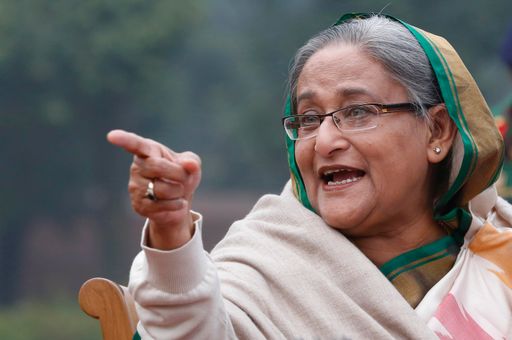Once a heavily guarded palace, the former official residence of Bangladesh's ousted Prime Minister Sheikh Hasina is being turned into a museum as a lasting reminder of her autocratic rule.
Photographs of jubilant flag-waving crowds, clambering onto the rooftop of the Dhaka palace after Hasina fled by helicopter to India, were a defining image marking the culmination of student-led protests that toppled her government on August 5, 2024.
One year later, with the South Asian nation of around 170 million people still in political turmoil, authorities hope the sprawling Ganabhaban palace offers a message to the future.
Graffiti daubed on walls condemning her regime remains untouched.
"Freedom," one message reads. "We want justice."
Hasina's rule marked widespread human rights abuses, including mass detentions and extrajudicial killings of her political opponents.
Up to 1,400 people were killed between July and August 2024 in her failed bid to cling to power, according to the United Nations.
The 77-year-old has defied court orders to attend her ongoing trial in Dhaka, on charges amounting to crimes against humanity, accusations which she denies.
"Dictator", another message reads, among scores being protected for posterity. "Killer Hasina".
Muhammad Yunus, the 85-year-old Nobel Peace Prize laureate leading the caretaker government until elections in early 2026, said the conversion to a museum would “preserve memories of her misrule and the people’s anger when they removed her from power.”

Getting over trauma
Mosfiqur Rahman Johan, 27, a rights activist and documentary photographer, was among the thousands who stormed the palace, where crowds danced in her bedroom, feasted on food from the kitchens, and swam in the lake Hasina once used for fishing.
"It will visualise and symbolise past trauma, the past suffering and also the resistance," he said.
"Ganabhaban is a symbol of fascism, the symbol of an autocratic regime".
The complex was built by Hasina’s father, Sheikh Mujibur Rahman, the founding leader of Bangladesh. She made it her official residence during her 15 years in power.
Tanzim Wahab, curator of the under-construction museum, said that exhibits would include artefacts belonging to protesters who were killed.
Their life stories will be told through films and photographs, while plaques will bear the names of those killed by security forces during the broader period of Hasina’s rule.
"The museum's deeper purpose is retrospective, looking back at the long years of misrule and oppression", said Wahab.
Wahab said the museum would include animation and interactive installations, as well as documenting the tiny cells where Hasina's opponents were detained in suffocating conditions.
"We want young people to use it as a platform for discussing democratic ideas, new thinking, and how to build a new Bangladesh," Wahab said.
Statues of dictatorship
But while Hasina's palace is being preserved, protesters have torn down many other visible signs of her rule.
Statues of Hasina's father were toppled, and portraits of the duo torn and torched.
Protesters even used digger excavators to smash down the home of the late Sheikh Mujibur Rahman, which Hasina had turned into a museum to her father.
Muhibullah Al Mashnun, a 23-year-old student who was among the crowds that tore down the house, believes removing such symbols was necessary for Bangladesh to move forward to a better future.
"They were the statues of dictatorship," Mashnun said.















